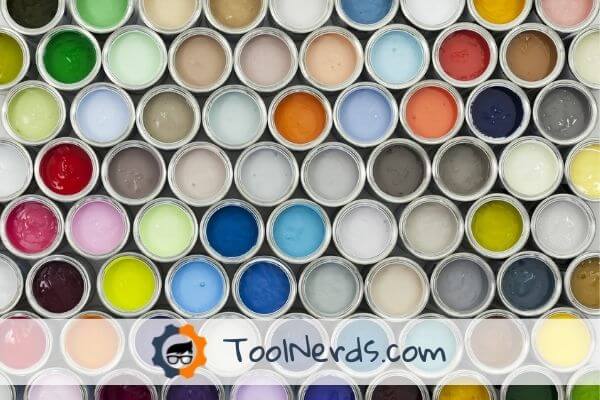
Your sprayer is ready and primed. You’ve prepped the target surface and all you need to crack on with your project is some paint — the simple part, right? Well, not necessarily!
Which medium format should you choose? How many coats? Should it be a thick, dense paint or a lighter one? Does it need thinning? Do you need a primer? Will it work with your sprayer?
The answer, as you’ll discover, depends upon your job’s particular requirements and the finish you wish to achieve. By understanding the types of paint, you can pick the best format for your sprayer — ensuring the ultimate finish.
The Structure of Paint
Before I crack on with the different types of paint — it’s necessary to understand a little painting chemistry. Stay with me, it’s more interesting than you think — well, a little bit.
The word ‘paint’, in the most general terms, relates to all fluid mediums that you apply to a secondary surface to bestow a topcoat — whether that’s to provide color, protect from the elements, give a pleasing shine, or shield from damage. As such, that includes all liquids from epoxies and roof-shielders through to shellacs and stains.
And, sticking with the general, all paint has two main constituent parts — a solvent and a solute.
Take a glance at your ceiling — assuming it’s painted. If not, look at something else. That color, sheen, and texture you can see above your head is the solute — which will, depending on the medium format, comprise antifungals, dyes, binders, water-repellers, and polymers.
However, the solvent has gone (unless you’ve literally just painted the ceiling).
The solvent is the liquid ingredient — the stuff that allows you to coat your target surface easily with a brush, or sprayed from a power painter. Without it, the paint would be an unusable, solid lump of ingredients.
As paint is exposed to air, it dries as the solvent evaporates — meaning all that you are left with is the solute.
While there are a few exceptions — usually, the paint solvent is either oil or water. The former being urethanes, varnishes, shellacs, and glosses — and the latter acrylics, roof-coatings, and latexes. Additionally, the waterborne paints are typically dense, and oil-based mediums low viscosity.
To Thin or Not to Thin
Pre-thinning of the paint is usually for one of two reasons — to deliver a less dense coat as required by your project, or to make the medium compatible with your sprayer.
For example, if you’re going for that shabby-chic, distressed look (really, why?), then diluting your medium will allow more of the base wood to show through, giving that aged appearance.
However, the most frequent purpose of thinning is to allow the paint to flow smoothly through a sprayer. Many dense mediums — such as latexes, chalks, milks, and epoxies — are too thick for lower-powered machines, meaning that dilution is necessary.
There are two key considerations — the format of the paint and the extent of thinning required.
Always dilute the paint with the same format as the base medium. Hence, water for waterborne paints and with spirits for oil-based liquids. Get it wrong, and the incompatible fluids will remain separate — ruining your coat.
The amount of dilution is the most challenging aspect — it depends on the base medium, the power output of the sprayer, and the nozzle size. It requires a little attention and the use of a viscosity cup and chart, measuring cup, and reference to the manufacturer’s specifications for your machine. As this is a little complicated, I’ve put together a complete guide to thinning here.
That said, you could just ensure that you choose a spraying unit that’s compatible with dense paints — check out my Best Sprayers for Thick Paints guide.
Types of Paint
Beneath the oil-based and waterborne umbrellas sit a plethora of coverage medium types. Created by lab-dwelling paint boffins, these liquids vary in their function, durability, and finish. Furthermore, the sprayer you need for these fluids can differ — depending on their viscosity.
Let’s get down to business.
Primer
Available in either water or oil-based formats, primer is the starting medium for many DIY and home-improvement projects — due to its ability to provide a suitable base, indicate imperfections, and cover old paint coats.
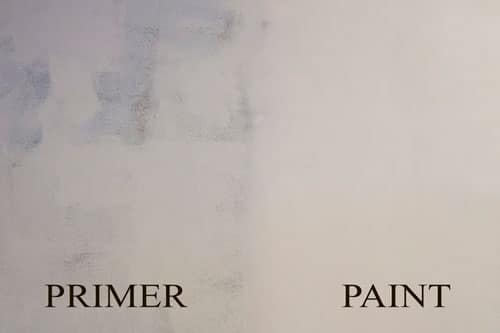
Firstly, an initial coat of primer provides a surface that your topcoat will readily ‘stick’ to. Waterborne paints, for example, will soak into fresh wood — leaving a disappointing, thin, and uneven finish — the primer gives you an initial base on which to work, ensuring a perfect coat. Furthermore, by increasing adhesion, primer prevents chips on metal surfaces such as car bodywork.
Secondly, many painting pros use primer (often thinned) to indicate flaws in the target surface — paint doesn’t hide imperfections, it emphasizes them. Giving your material a quick covering of primer allows you to see where the surface is uneven, chipped, or scratched — meaning you can address it with sandpaper and filler.
Thirdly, primer acts as a clean slate — covering old and tired paintwork and permitting smooth and even coverage, without the aged medium showing through your new coat.
For the paint spraying aficionado, there’s one key consideration — primer is highly viscous.
This means that you need a unit with some serious grunt — such as the pneumatic Iwata LPH440-181, the airless Control Pro 190, or the HVLP Wagner MotoCoat. For a detailed explanation on using primer, and examples of the best sprayers in this category — check out my Priming Guide.
Alkyd
An older format of paint that has fallen out of fashion due to the introduction of modern vinyls and enamels — although, it keeps a faithful following among tradition-loving DIYers.
Although often referred to as an oil-based medium — it’s not. Instead, it has a solvent base of either alcohol or mineral spirits — the incorrect reference is due to its shiny and durable finish that mimics that of oils.
Alkyds utilize resin or polyester as the binding ingredient — making them able to withstand some serious hardcore abuse and repel water. Hence, it’s used in high-traffic, wood surfaces such as hallways, kitchens, and bathrooms.
Furthermore, due to its powerful binder — you can apply alkyds onto existing latex paint, or onto fresh timber without the use of a primer.
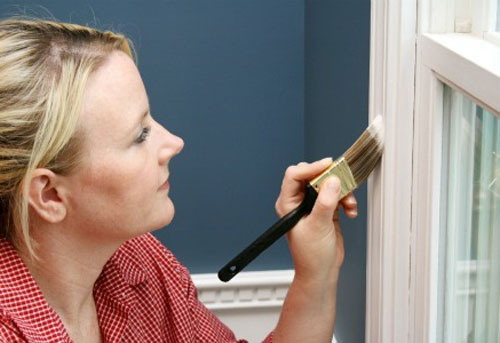
The downsides are two-fold. Firstly, it’s one of the more environmentally toxic coating mediums — so if you like clean rivers and fishes — steer clear. Secondly, the binding polymers can make the paint spatter when used with a spray gun.
Hence, while you can use a powerful turbine unit, ideally, go for an airless machine, such as the Graco Project Painter Plus. Not only does the high-pressure output of these hydraulic sprayers allow the delivery of dense alkyds, but also the continuous, non-fluctuating power prevents spatter and coughing.
Lacquer
A versatile and durable medium — but one that can take significant effort to apply correctly.
While there are four main formats of lacquer — acrylic, waterborne, catalyzed, and cellulose — they share a similar thin consistency. Utilized to provide a robust, hard-wearing, water-resistant, and clear coat — they’re typically used on metal and wood — especially fine furniture. And, although durable, they remain breathable, enabling the base material to flex.
Lacquer has become something of an umbrella term for varnishes and shellacs. Strictly speaking, it differs in that it dries via mineral spirit evaporation as opposed to oils. However, the terms are used interchangeably by DIYers and trade pros.
Due to its low viscosity, even the most basic turbine sprayer will have sufficient grunt to propel this medium. However, it’s important that the machine achieves fine-atomization via a narrow tip for a truly smooth coat. For the DIY user, I recommend the Wagner Control 250 — and for trade pros, the Campbell Hausfeld DH580000AV.
And, once you’ve completed spraying — the work isn’t over.
For a mirror-like sheen, you need to spray, allow to dry, and then sand. Then repeat. And repeat. And repeat again — leading to an impressive French Polish finish. If you want more information, check out my guide to Lacquer Spraying.
Enamel
Drying to a durable, hard, and water-resistant finish, enamel paint is often utilized in areas subject to high traffic and finger-touching, model-building, and outdoor surfaces. As such, it’s used on window and door frames, kitchen cabinets, handrails, and patio furniture.
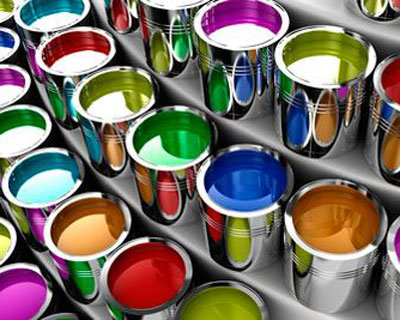
Usually oil-based, although there are some nitrocellulose formats on the market, it’s seriously rapid-drying. Meaning that the majority of projects will need to be completed in one session, to prevent painting a wet coat onto dry — which will ruin the finish.
And it’s with enamel paints that paint sprayers come into their own.
You could try applying this medium with a brush or roller — but it would be a disaster. Viscous and highly adhesive, it will show every brushstroke as well as pulling out the bristles.
You need a fairly powerful unit together with a fine tip to achieve the ultimate results — or, if you don’t own a sprayer, at the very least purchase it in a spray can. Personally, for fine work, I’d utilize a pneumatic HVLP gun like the Sagola 475, or the Titan Capspray 75 for more substantial projects. Take a look at my How-To guide for tips on using enamel paints.
Just a quick heads-up.
Don’t confuse enamel spray paint with vitreous enamel. The latter is paint which is fired in a kiln, for example, on porcelain crockery. What’s more, it’s not enamel — it’s made from powdered glass.
Acrylic, Vinyl, and Latex
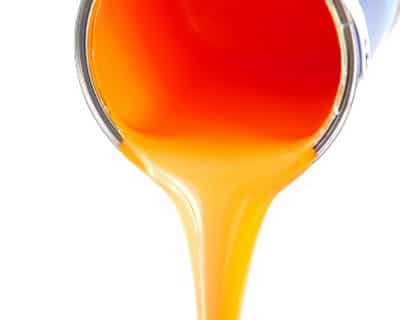
All three of these paints are the same — but different.
Home-improvers, DIYers, and trade-pros use these terms interchangeably, usually because they share the same features of:
- Being medium to high density.
- Flexible.
- Water-based.
- Available in satin, gloss, and matte sheens.
- Used for addressing walls and ceilings.
Here’s the key.
The term ‘latex’ indicates that the paint uses waterborne polymer microparticles as the binding compound — and the acrylic and vinyl names refer to the format of those polymers.
Acrylic paints utilize acrylic acid alkyl ester as the binder — and vinyl uses vinyl chloride. So, acrylics and vinyls are both latexes, but acrylic isn’t vinyl.
Got it?
If not, it doesn’t matter. In real-world applications, the importance is this — acrylics are more elastic than vinyls — meaning they can withstand temperature-related expansions and contractions without cracking or peeling, making them excellent for outdoor use.
Vinyls are most commonly found on interior walls, as they don’t require elasticity and are easier to clean.
The dense nature of latexes, and the fact that they are typically addressed to large areas such as walls and ceilings — mean you need a beefy sprayer with a wide diameter tip, such as the turbine Fuji Mini-Mite 4 or airless Titan 440. If you’re planning on using this medium in your home, take a look at my How To Spray Paint With Latex guide.
Epoxy
Possibly the densest paint on the market, epoxy is a water-based coverage medium that features a precise combination of polymers bound to either a latex or acrylic compound.
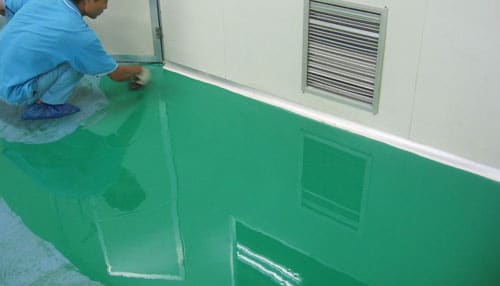
Remarkably hard-wearing, this paint is utilized in areas that are exposed to extreme use or abuse — such as on flooring, marine applications, industrial machinery, and wind turbines. Epoxy can be found in two-part format — resin and hardener — that needs to be mixed prior to use, and as a one-part formula, which you can use straight out of the can.
The main disadvantage with this robust medium is that it really doesn’t like UV light. Exposure to this end of the spectrum leads to rapid deterioration, powdering, and yellowing. Hence, if used in outside applications, it’s typically protected by an additional layer of latex or acrylic paint. For indoor jobs, such as on garage floors, this isn’t usually a consideration.
For the DIYer — the issue is the power of the sprayer. As an incredibly heavy and viscous paint — even the impressive power of a standard airless machine will struggle to propel the medium adequately.
Hence you need a prosumer/industrial grade unit rated for epoxy use — such as the Titan 440 or Graco ProX17. Since epoxy can be challenging to apply, I recommend checking out my How To Use Epoxy With a Sprayer Guide.
Plasti Dip
A relatively new paint format that didn’t hit the market until 1972. Originally designed for the industrial manufacture of toys and handle grips, this rubberized medium provides protection from moisture, acidity, corrosion, and abrasion — while also flexing without cracking issues.
It can handle temperatures up to 1,200 degrees Fahrenheit.
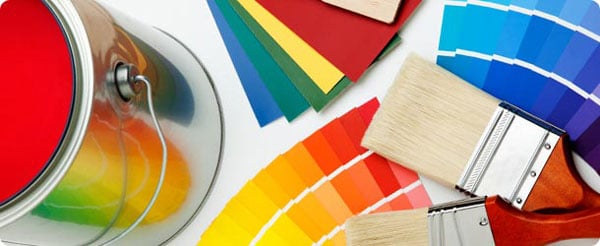
However, it was when automotive restoration enthusiasts discovered this material that it took on mainstream appeal. Available in a plethora of colors, suitable for application to metal bodywork, and the ability to peel it off effortlessly if you screw up — it became the motor customization favorite.
Care needs to be taken when thinning, as the base compound can be a variety of solvents, including hexane, naphtha, acetone, or xylene — hence you need to ensure your dilution medium matches the main constituent of the paint. Furthermore, when thinning, the color tone will be dulled, so you may need to add additional Plasti Dip tint.
While most powerful turbines will propel this medium — like the Earlex 5500 — due to the specific nature of the paint, it may be worth considering a unit designed for its application, such as the DYC DipSprayer System. If you want more detail, check out my Plasti Dip 101.
Chalk Paint
Created by the paint brand Annie Sloane, this water-based liquid delivers a matte coat, giving furniture a pleasing aged, distressed, rustic appearance — or makes your cabinets and chairs look like they’re ready for the trash — depending on your point of view.
Once applied, enthusiastic DIYers (that is, middle-aged female crafters with cats) finish with wax or lacquer to protect the flaky surface. One of the attractions of this paint is that it can be applied straight onto wood without priming or sanding — as apparently it enhances the shabby-chic appeal, whatever that is.
Being water-based, it requires a paint sprayer with a little grunt — I’m talking about units such as the Wagner FLEXiO 5000 or Graco 17M363. If you want more detail on this ‘unique’ coating medium, check out my Chalk Paint Spraying article.
Stains
Utilized for enhancing the natural beauty of wood, and for protecting against moisture ingress and knocks — stains are one of the most straightforward paints to apply, making them an excellent starting medium for the spraying newbie.
Although available in both water and oil-based formats, the higher water-repelling nature of the oil type makes it the most popular. As such, these are relatively fuss-free to deliver from a power-painter — meaning you don’t need the mother-of-all-sprayers to achieve impressive results.
Hence, a DIY-focused turbine or HVLP pneumatic gun is sufficient to propel stains — like the Wagner Control Spray 250 or Campbell Hausfeld DH580000AV. It’s crucial when using a stain sprayer to keep the power to a minimum and with the narrowest tip possible — as this medium is liable to overspray, pooling, and wastage.
For top tips, on using stains with a paint machine — check out my Stain Spraying guide.
Roof Coatings
While you may get away with using a brush or a roller with the other mediums in this article — there’s no chance with a roof-coating. Unless you’re a serious glutton for punishment, this incredibly dense — and often textured paint — virtually necessitates the use of a sprayer.
Designed to protect and waterproof roofs, this coverage medium— available in water or oil-based formats — has elastomeric properties which vastly increases its viscosity. These impressive polymers allow for a large degree of flex, preventing cracking and ruining the integrity of the coat.
Remember the convicts slaving away on the prison roof applying paint in the Shawshank Redemption (1994)? It took 20 guys weeks to finish that job — simply because they didn’t have a paint sprayer. If you’ve never seen the movie, stream it today.
Due to its high density — you need a mighty power painter. Forget turbines and pneumatics, for this job, you require the 3000 PSI-plus output of an airless machine, like the Graco Pro X19 or Graco 695. As applying this beast-like paint can be challenging, I suggest taking a look at my How To guide.
Milk
The most environmentally friendly of all the paints — hence if you’re a Greta Thunberg fanatic — this should be your coating medium of choice.
Made from 100 percent natural ingredients — usually milk protein (casein), lime, and pigments — it has the advantages of being non-toxic, fumeless, fast-drying, and biodegradable. Sold in powder form, you simply add water, mix, and paint.
Sounds amazing, right?
Well, it is if it’s your kind of thing. When used on wood, it has the appearance of chalk paint — distressed, worn, and old. On drywall and render, it’s liable to chipping — and despite being dense, requires numerous coats for a suitable coat thickness.
The water-based formula means it necessitates a fairly powerful sprayer — so if you fancy using this tree-hugging paint, check out the Graco X5 or Wagner 5000.
Conclusion
You put a lot of time into finding a paint sprayer. You need to do your research when choosing types of paint, too.
While many of the paints on this list are versatile, some are better for certain projects than others. Some of these are fast-drying, others are thicker, and others still should only be used as a finish.
Next time you pick up your paint sprayer, you’ll know just which paints to use.
Looking for more information about paint sprayers now that you’ve chosen your paints?
At Tool Nerds, you can read reviews and detailed information about all types of sprayers, including professional sprayers, airless paint sprayers, turbine paint sprayers, and more. We can help you pick the best sprayer for the job every time.










